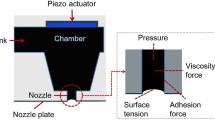Abstract
In this study, the generation of inkjet droplets of xanthan gum solutions in water–glycerin mixtures was investigated experimentally to understand the jetting and drop generation mechanisms of rheologically complex fluids using a drop-on-demand inkjet system based on a piezoelectric nozzle head. The ejected volume and velocity of droplet were measured while varying the wave form of bipolar shape to the piezoelectric inkjet head, and the effects of the rheological properties were examined. The shear properties of xanthan gum solutions were characterized for wide ranges of shear rate and frequency by using the diffusive wave spectroscopy microrheological method as well as the conventional rotational rheometry. The extensional properties were measured with the capillary breakup method. The result shows that drop generation process consists of two independent processes of ejection and detachment. The ejection process is found to be controlled primarily by high or infinite shear viscosity. Elasticity can affect the flow through the converging section of inkjet nozzle even though the effect may not be strong. The detachment process is controlled by extensional viscosity. Due to the strain hardening of polymers, the extensional viscosity becomes orders of magnitude larger than the Trouton viscosities based on the zero and infinite shear viscosities. The large extensional stress retards the extension of ligament, and hence the stress lowers the flight speed of the ligament head. The viscoelastic properties at the high-frequency regime do not appear to be directly related to the drop generation process even though it can affect the extensional properties.












Similar content being viewed by others
References
Basaran O (2002) Small scale free surface flows with breakup: drop formation and engineering applications. AIChE J 48:1842–1848
Batchelor GK (1967) An introduction to fluid dynamics. Cambridge University Press, Cambridge
Bird RB, Armstrong RC, Hassager O (1987) Dynamics of polymeric liquids. Wiley, New York
Bogy DB, Talke FE (1984) Experimental and theoretical study of wave propagation phenomena in drop-on-demand ink jet devices. IBM J Res Dev 28:314–321
Chilcott MD, Rallison JM (1988) Creeping flow of dilute polymer solutions past cylinders and spheres. J Non-Newton Fluid Mech 29:381–432
de Gans BJ, Duineveld PC, Schubert US (2004) Inkjet printing of polymers: state of the art and future developments. Adv Mater 16:203–213
de Gans BJ, Xue L, Agarwal US, Schubert US (2005) Ink-jet printing of linear and star polymers. Macromol Rapid Comm 26:310–314
Derby B (2010) Inkjet printing of functional and structural materials: fluid property requirements, feature stability, and resolution. Ann Rev Mater Res 40:395–414
Dong H, Carr WW, Morris JF (2006) An experimental study of drop-on-demand drop formation. Phys Fluids 18:072102
Eggers J (1993) Universal pinching of 3D axisymmetric free-surface flow. Phys Rev Lett 71:3458–3460
Evans JD, Hagen T (2008) Viscoelastic sink flow in a wedge for the UCM and Oldroyd-B models. J Non-Newton Fluid Mech 154:39–46
Fontelos MA, Li J (2004) On the evolution and rupture of filaments in Giesekus and FENE models. J Non-Newton Fluid Mech 118:1–16
Hoath SD, Hutchings IM, Martin GD, Tuladhar TR, Mackley MR, Vadillo D (2009) Links between ink rheology, drop-on-demand jet formation, and printability. J Imaging Sci Technol 53:041208
Hoath SD, Harlen OG, Hutchings IM (2012) Jetting behavior of polymer solutions in drop-on-demand inkjet printing. J Rheol 56:1109–1127
Hull AM (1981) An exact solution for the slow flow of a general linear viscoelastic fluid through a slit. J Non-Newton Fluid Mech 8:327–336
Lai JM, Lin JD, Linliu K (2010) Numerical investigation of the effect of a transducer pulse on the microfluidic control of a piezoelectric printhead. J Micro-Nanolith Mem 9:033010
McKinley GH (2005) Visco-elasto-capillary thinning and break-up of complex fluids. Rheol Rev 2005:1–48
Morrison NF, Harlen OG (2010) Viscoelasticity in inkjet printing. Rheol Acta 49:619–632
Papageorgiou DT (1995) On the breakup of viscous liquid threads. Phys Fluids 7:1529–1544
Renardy M (2002) Similarity solutions for jet breakup for various models of viscoelastic fluids. J Non-Newton Fluid Mech 104:65–74
Renardy M (2004) Self-similar breakup of non-Newtonian liquid jets. Rheol Rev 2004:171–196
Schubert US (2005) Ink-jet printing of functional polymers and materials: a (future) key technology in polymer science. Macromol Rapid Commun 26:237–237
Shore HJ, Harrison GM (2005) The effect of added polymers on the formation of drops ejected from a nozzle. Phys Fluids 17:033104
Son YS, Kim C, Yang DH, Ahn DJ (2008) Spreading of an inkjet droplet on a solid surface with a controlled contact angle at low Weber and Reynolds numbers. Langmuir 24:2900–2907
Stelter M, Wunderlich T, Rath SK, Brenn G, Yarin AL, Singh RP, Durst F (1999) Shear and extensional investigations in solutions of grafted/ungrafted amylopectin and polyacrylamide. J Appl Polym Sci 74:2773–2782
Stelter M, Brenn G, Yarin AL, Singh RP, Durst F (2002) Investigation of the elongational behavior of polymer solutions by means of an elongational rheometer. J Rheol 46:507–527
Stone HA (1994) Dynamics of drop deformation and breakup in viscous fluids. Ann Rev Fluid Mech 26:65–102
Stone HA, Bently BJ, Leal G (1986) An experimental study of transient effects in the breakup of viscous drops. J Fluid Mech 173:131–158
Tai J, Gan HY, Liang YN, Lok BK (2008) Control of droplet formation in inkjet printing using Ohnesorge number category: materials and processes. In: 10th electronics packaging technology conference. IEEE, pp 761–766
van Dam DB, Le Clerc C (2004) Experimental study of the impact of an ink-jet printed droplet on a solid substrate. Phys Fluids 16:3403–3414
Acknowledgement
This work was partially supported by Mid-career Researcher Program through NRF grant funded by the Ministry of Education, Science and Technology, Korea (no. 2010–0015186).
Author information
Authors and Affiliations
Corresponding author
Rights and permissions
About this article
Cite this article
Yoo, H., Kim, C. Generation of inkjet droplet of non-Newtonian fluid. Rheol Acta 52, 313–325 (2013). https://doi.org/10.1007/s00397-013-0688-4
Received:
Revised:
Accepted:
Published:
Issue Date:
DOI: https://doi.org/10.1007/s00397-013-0688-4




